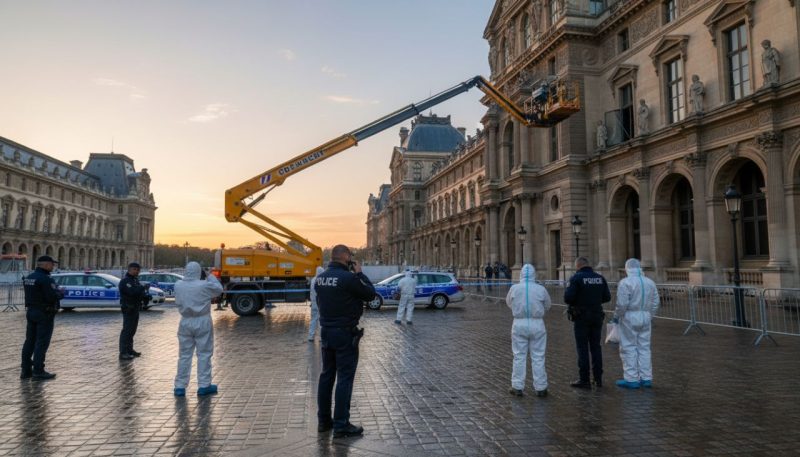
The world’s most-visited museum woke up to humiliation this week. In a scene that could have been lifted straight from an art-house crime film, masked thieves used a mechanical lift to break into Paris’s Louvre Museum, departing with eight pieces of France’s crown jewels—royal heirlooms of the Napoleonic era now described by the French interior minister as “beyond value.” The robbery, officials said, took less than seven minutes.
A Dazzling Crime in Broad Daylight
The heist took place around 9:30 a.m. local time on October 19, 2025—just as the museum opened its doors. Four thieves, disguised as construction workers, used a truck-mounted lift to access a second-floor window of the Galerie d’Apollon, the opulent 17th-century hall that houses the French crown jewels. Armed with angle grinders and small chainsaws, they smashed display cases containing 19th-century diadems, necklaces, and brooches once owned by Europe’s imperial royalty.
Two pieces—including Empress Eugénie’s diamond crown—were later found broken outside the museum, apparently dropped as the thieves fled on motorbikes. Visitors were evacuated amid confusion; witness accounts described “panic” as alarms sounded but failed to trigger a full lockdown. The entire operation, French Interior Minister Laurent Nuñez said, was a “highly organized attack executed with professional precision”.
What Was Taken
The French Ministry of Culture confirmed that eight objects were stolen, all of “inestimable heritage and historical value.” They include:
- A tiara and brooch belonging to Empress Eugénie, wife of Napoleon III.
- An emerald necklace and earrings from Empress Marie Louise, Napoleon Bonaparte’s second wife.
- A sapphire tiara, necklace, and single earring from Queen Marie-Amélie and Queen Hortense’s collection.
- The so-called Reliquary Brooch, a 19th-century masterpiece of gold and diamond filigree.
The material worth runs into millions. But as officials, curators, and historians have stressed, the true value lies in the cultural wound—these are not commodities but symbols, France’s physical memory rendered portable.
Security in Question
The Louvre’s security record isn’t spotless—the Mona Lisa was famously stolen in 1911—but this hits differently. This was not a lone opportunist sneaking out under a coat. It was an assault on the prestige infrastructure of the French state. Reports from BBC indicate that a third of the raided rooms lacked CCTV coverage, and that a local alarm system had been malfunctioning. Culture Minister Rachida Dati admitted that the thieves “entered calmly,” while Paris Senator Natalie Goulet called it “a national embarrassment.”
These failures sting especially because the government only months ago launched a €700–800 million “New Renaissance” plan to modernize and secure the museum. The President himself had promised that the Louvre would be “redesigned for the century ahead.” Instead, France now faces headlines about crown jewels stolen under his watch—a metaphor almost too convenient for his critics.
Politics in the Aftermath
The political fallout has been immediate. President Emmanuel Macron, echoing the shocked tone of his predecessors after Notre-Dame’s fire, declared the heist “an attack on our history.” In contrast, far-right National Rally leader Jordan Bardella seized the symbolism: “How far will the decay of the French state go?” he posted on X. For the far-right, each cultural embarrassment folds neatly into a narrative of national decline.
Behind this rhetoric is a legitimate question about institutional drift. How does a museum that houses the **Regent Diamond—valued at $60 million—**get hit in daylight by men with power tools and a rented crane?
The Global Stakes of Cultural Theft
The Louvre robbery joins a growing list of European museum heists targeting historical artifacts rather than contemporary art. Last year’s porcelain theft in Limoges (€9.5 million) and the Natural History Museum gold robbery (€600,000) underline how professional gangs now hunt cultural capital with near-military planning. It’s heritage laundering—items broken down into parts, melted or recut for resale through shadow networks that stretch from Antwerp to Hong Kong.
International art recovery experts, like Christopher Marinello of Art Recovery International, warned that time is short. “They’re not going to keep them intact,” he told ABC. “They’ll be broken apart, melted down, their stones recut, their provenance erased.” Once that happens, France won’t just lose jewels—it will lose chapters of its story.
France’s Mirror Moment
There’s something poetic—if accidentally tragic—in the location: the Galerie d’Apollon, named for the sun god, built by Louis XIV as a prototype for Versailles’s Hall of Mirrors. A temple to eternal glory breached by modern criminal efficiency. For a country that sees itself as the custodian of civilization, this is personal.
The Louvre will likely reopen within days. But its reopening will not erase the unease: that in the city of light, in the most guarded cultural fortress on Earth, history itself was looted in seven minutes flat.
